Advertisements
Advertisements
Question
Fig. shows two rays of light Op and OQ coming from an object at the bottom of a pond, incident on the water surface.
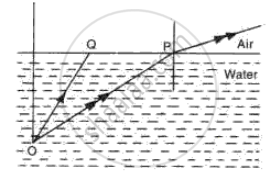
(a) Mark on the diagram
(i) The angle of incidence of ray OP,
(ii) The angle of refraction of ray Op,
(iii) The position of image of the object as seen from above.
(iv) An approximate path of the ray OQ.
(b) Explain, why do the rays of light change directions on passing from water to air.
(c) A fish in water sees everything outside the water by rays of light entering its eye in a small cone of light. Draw a diagram and explain how does this happen.
Solution

(i) Angle of incidence (i) of ray OP is marked in the above diagram.
(ii) Angle of refraction (r) of ray OP is marked in the above diagram.
(iii) The position of image of the object (O') as seen from above is marked in the diagram.
(iv) An approximate path of ray OQ is shown in the above diagram.
(b) Water is a denser medium as compared to air; so on passing from water (denser) to air (rarer) the speed of light of light increases and it bends away from the normal.
(c)
Refraction is the bending of light as it passes from a medium of one optical density into a medium of a different optical density, as from air to water or water into air. The amount of bending is dependent upon the incident angle of the light. In the diagram below, a light ray, "A" strikes the water at right angles and passes through the surface without bending. But as the incident angle decreases (becomes less than 90 degrees) the light bends more and morerays "B" and "C." Light striking the surface parallel to the surface, bends downward.
Since light is coming into the water from all directions, refraction creates a cone of light with its base on the surface and its apex at the fish's eye. The base of the cone is a circular opening at the surface through which the fish sees the entire outside world. This opening is called the "Fish's Window". Only the light passing through the window enters the fish's eye. Notice line "D," It's a ray entering the water beyond the window; refraction bends it such that it cannot reach the fish's eye.
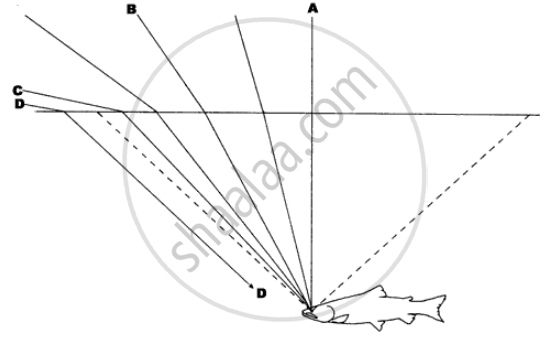
APPEARS IN
RELATED QUESTIONS
Explain optical centre of a lens with the help of proper diagram(s).
State the condition when a lens is called an equi-convex or equi-concave.
In the diagram below, XX’ represents the principal axis, O the optical centre and F the focus of the lens. Complete the path of rays A and B as they emerge out of the lens.
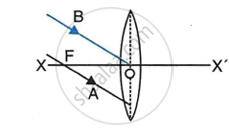 |
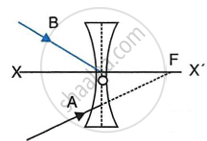 |
| (a) | (b) |
The diagram given below shows the position of an object OA in relation to a converging lens L whose foci are at F1 and F2.
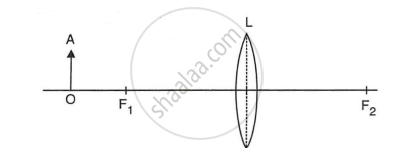
- Draw two rays to locate the position of the image.
- State the position of the image with reference to the lens.
- Describe three characteristics of the image.
- Describe how the distance of the image from the lens and its size change as the object is moved towards F1.
The diagram given below shows the position of an object OA in relation to a converging lens whose foci are at F1 and F2.

Describe how the distance of the image from the lens and the size of the image change as the object is moved towards F1.
In the following diagram , the object and the image formed by the respective lenses are shown. Complete the ray diagram, and locate the focus. Find the focal length of the lens.

(a)A ray of light is incident at 45° on the face of
(i) A rectangular block of glass.
(ii) A 600 glass prism.
(b) Draw a sketch showing how the ray of monochromatic ray of light passes through glass in each case.
(c) With the aid of a diagram, explain how the face of a right angled prism may totally reflect incident on it.
(d) A thick plane mirror produces several faint images in addition to a prominent one. Draw a ray diagram showing how reflection and refraction produce all these images.
(e) Fig. represents a stone S at the bottom of a pond of water. Using the two rays, as shown, complete the ray diagram to show where the image of the stone appears when viewed from E.

(f) What is a''mirage'? Explain with the help of a diagram.
(g) A man observes the bottom of a swimming pool of 3 m depth. If the refractive index of water is 1.3, what is the apparent depth of water?
(h) When a ray of light undergoes refraction through a glass slab and when it emerges it is displaced laterally (Fig). What are the factors on which the lateral displacement depends?
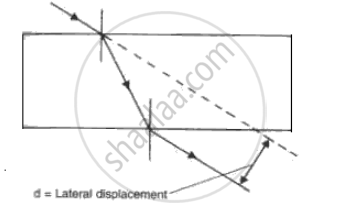
(i) Fig. shows three rays of light OA, OB and OC passing from water to air, making angles 490, 410 and 350 with the horizontal surface respectively. Draw an approximate path of the emergent ray for each. (Critical angle of water is 490.)
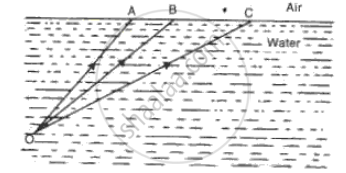
How will you differentiate between a convex and a concave lens by looking at a printed page?
Complete the following diagram and state what happens to the ray of light after refraction through the lens.

